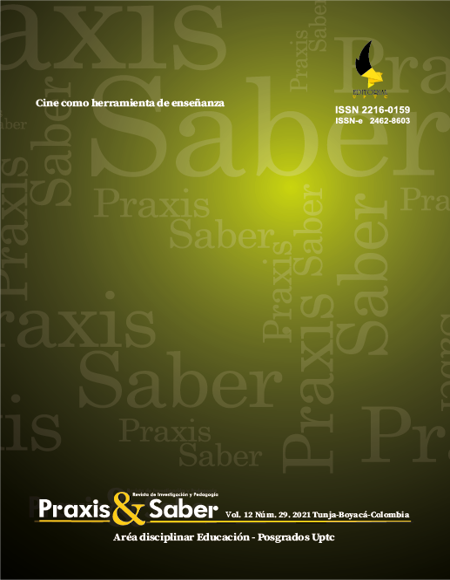El cine como recurso pedagógico para promover el engagement en la educación superior

Abstract
The use of cinema in an educational context adds opportunities in an upward spiral, bringing out senses and meanings for new and exciting learnings. This article aims to analyze whether the use of cinema in an educational context promotes emotional, physical and cognitive engagement. Methodologically, the study combines a qualitative investigation, supported by the assumptions of Bardin (2010). The results reveal that the students consider that the use of cinema can provide: 1) levels of emotional, physical and cognitive engagement facilitated and enhanced, 2) sharing of more optimized knowledge, 3) expansion of vocabulary and cultural background, 4) affinity with the challenge and research, 5) appreciation of the opinion of peers, 6) improvement in self-perception, motivation and interest in deepening themes focused on the discipline, 7) immediate and optimized feedback, culminating in teacher-student satisfaction.
Keywords
portugues
Author Biography
Sara Dias-Trindade
Departamento de História, Estudos Europeus, Arqueologia e Artes
Faculdade de Letras da Universidade de Coimbra
Centro de Estudos Interdisciplinares do Século XX
José António Moreira
Diretor da Delegação Regional do Porto
Coordenador Executivo da Unidade de Desenvolvimento dos Centros Locais de Aprendizagem
Universidade Aberta
References
Astin, A. (1993). What matters in college? Four critical years revisited. Jossey-Bass.
Bardin, L. (2010). Análise de conteúdo. Persona.
Burch, G., Heller, N., & Burch, J. (2015). Student engagement: developing a conceptual framework and survey instrument. Journal of Education for Business, 90(1), 224-229.
Burke, P. (2004). Testemunha ocular: história e imagem. EDUSC.
Caparros, J. (2008). Grandes acontecimientos históricos contemporáneos en el cine. Em G. Camarero, B. Heras, & V. Cruz, (Eds.), Una ventana indiscreta: la historia desde el cine (pp. 131-147). Ediciones JC.
Carneiro, J., Orsini, A., & Costa, F. (2018). Escala de engajamento de discentes universitários: adaptação e revalidação para o contexto brasileiro. Meta: Avaliação, 10(30), 600-620.
Dias-Trindade, S. (2018). Ferramentas digitais para desenvolvimento de cenários de aprendizagem onde o cinema pode ser a estrela. Em J. Moreira, P. Alves, & F. García (Eds.), Fusões no Cinema: Educação, Didática e Tecnologia (pp. 113-125). Whitebooks.
Dias-Trindade, S. (2020). Moving pictures: a way of understanding and studying history in higher education. Em Á. Abellán-García (Ed.), Cada imagen es un mundo (pp. 135-148). Editorial Sindéresis.
Dias-Trindade, S., & Carvalho, J. (2019). História, tecnologias e mobile learning. Ensinar história na era digital. Imprensa da Universidade de Coimbra.
Dias-Trindade, S., & Ribeiro, A. (2016). O espaço do cinema na didática da História. Revista de Linguagem do Cinema e do Audiovisual, 2, 28-34.
Fernández, A. (2012). A Atenção Aprisionada: Psicopedagogia da Capacidade Atencional, Penso. Porto Alegre.
Ferro, M. (1988). Cinema and History. Wayne State University Press.
Kahu, E., Nelson, K., & Picton, C. (2017). Student interest as a key driver of engagement first year students. Student Success, 8(2), 55-66.
Lagny, M. (2009). O cinema como fonte de história. Em J. Nóvoa, S. Fressato, & K. Feigelson (Eds.), Cinematógrafo: um olhar sobre a história (pp. 99-131). EDUFBA/Editora UNESP.
Mehta, J., & Fine, S. (2015). The why, what, where, and how of deeper learning in American secondary schools. Students at the center; Jobs for the Future. https://jfforg-prod-new.s3.amazonaws.com/media/documents/The-Why-What-Where-How-121415.pdf
Moreira, J. (2017). A pedagogical model to deconstruct moving pictures in virtual learning environments and its impact on the self-concept of postgraduate students. Journal of e-Learning and Knowledge Society, 13(1), 77-90.
Moreira, J., & Vieira, C. (Orgs.). (2017). eLearning no Ensino Superior. Cinep/IPC.
Nogueira, I. (2000). O cinema e o ensino da História. O Ensino da História, 18, 36-47.
Ortoleva, P. (1991). Cinema e storia: scene dal passato. Editora Loescher.
Pascarella, E., & Terenzini, P. (2005). How college affects students. Vol. 2. Jossey-Bass.
Rosenstone, R. (1995). Introduction to revisioning history: film and the construction of a new past. Princeton University Press.
Rosenstone, R. (1997). El pasado en imágenes: el desafío del cine a nuestra idea de la historia. Ariel.
Saavedra, A., & Opfer, V. (2012). Teaching and learning 21st century skills: lessons from the learning sciences. Asia Society; Rand Corporation. https://www.aare.edu.au/data/publications/2012/Saavedra12.pdf
Simon, H. (1996). The sciences of the artificial (3ª ed.). The MIT Press.
Sinay, E. (2014). Global learning and teaching with educational technology in the Toronto District School Board. Toronto District School Board.
Sinay, E., & Graikinis, D. (2018). Global competencies in deeper learning environments enabled by pervasive digital technologies: Evolving framework for theoretical foundation and developmental evaluation. Toronto District School Board.
Smith, K., Sheppard, S., Johnson, D., & Johnson, R. (2013). Pedagogies of Engagement: Classroom-Based Practices. Revista de Educación en Ingeniería, 94, 87-101. https://doi.org/10.1002/j.2168-9830.2005.tb00831.x
Spiro, R. (2002). Pioneering a new way of learning in a complex and complicated world. New Educator.
Trowler, V., & Trowler, P. (2010). Student engagement evidence summary. The Higher Education Academy. http://eprints.lancs.ac.uk/61680/1/Deliverable_2._Evidence_Summary._Nov_2010.pdf
Unesco. (2015). The futures of learning 3: What kind of pedagogies for the 21st century? http://unesdoc.unesco.org/images/0024/002431/24 3126e.pdf
